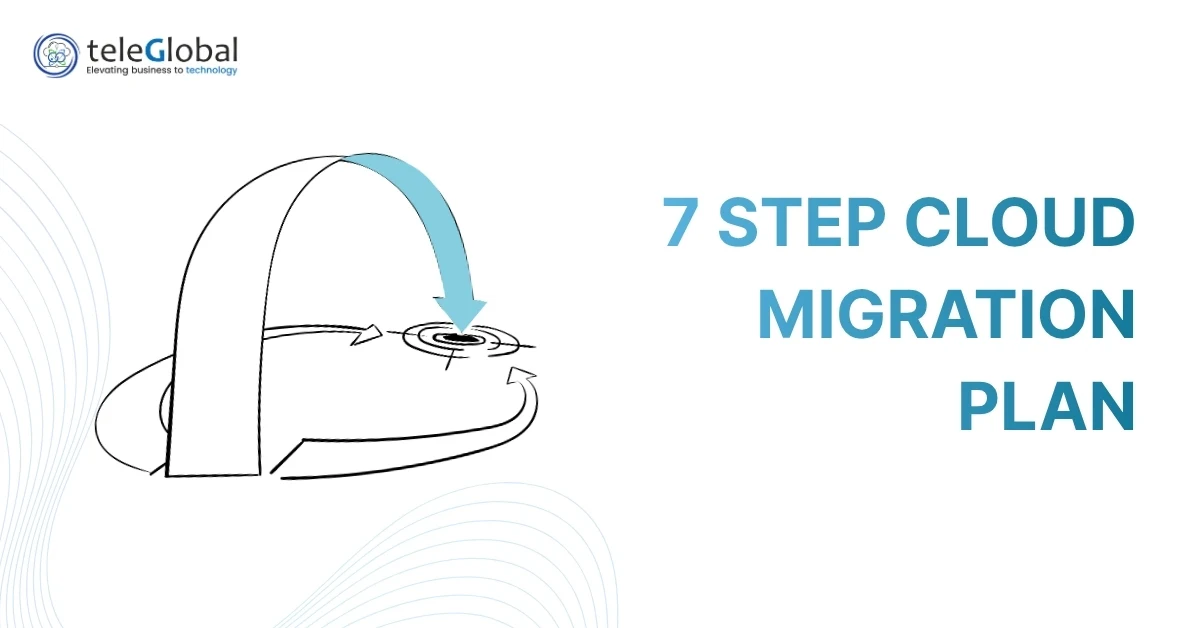
| Author: Kamlesh Kumar | Published: 07-Nov-2025 |
Modern enterprises must move decisively to the cloud or risk falling behind. Today, more than 85% of organizations will be “cloud-first” by 2025, and new digital workloads are overwhelmingly begin in the cloud. A well‑structured cloud migration plan is critical for executives to achieve business agility, control costs, and mitigate risk. For example, Teleglobal helped a media client cut storage costs by ~90% during cloud modernization. In this 7-step roadmap, we outline concrete actions from defining objectives to optimizing operations – so your migration delivers measurable ROI, secure operations, and on-schedule execution.
Each step below is framed for decision-makers: we explain what to do, why it matters, and how to track success. You’ll find recommended KPIs, governance guidance (RACI), timeline estimates, and risk mitigations. This plan aligns with TeleGlobal’s cloud consulting and implementation approach (e.g. free Cloud Infrastructure Assessments) and shows the strategic benefits your board expects.
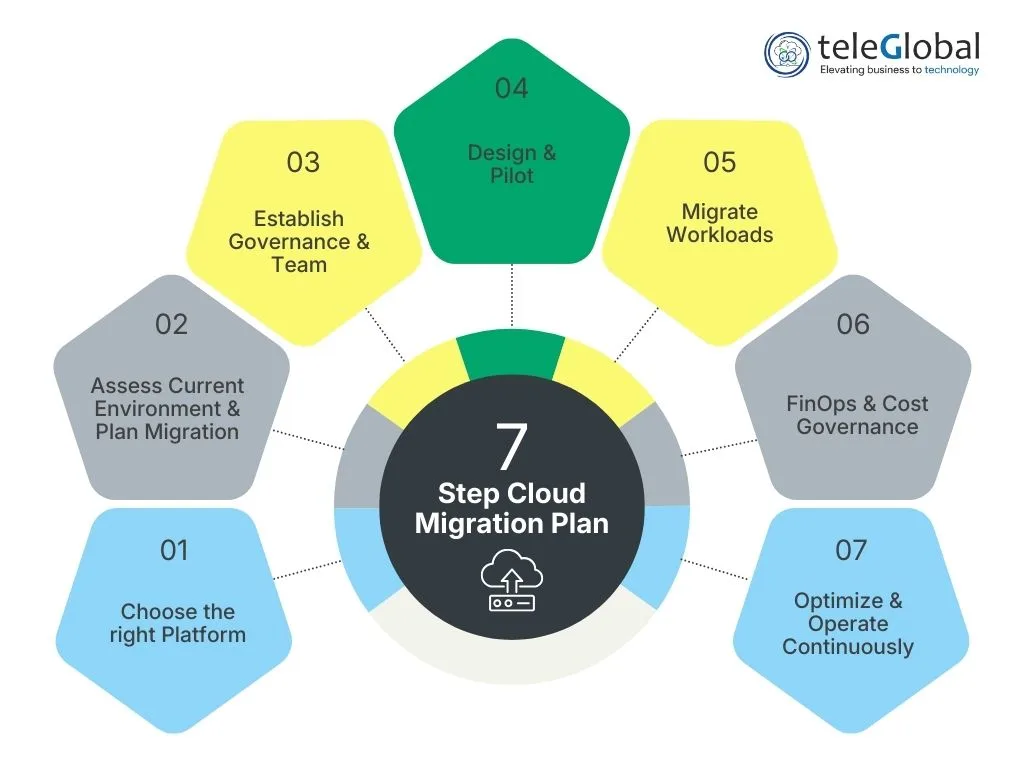
Begin with a clear cloud strategy and business case. Set top‑level goals (cost reduction, agility, innovation) and success metrics before any technical work. At this stage, the board must agree on “why cloud?” – whether for cost savings, speed to market, resilience, or digital transformation. Engage finance early: quantify expected ROI, TCO reduction, or revenue gains. For example, AWS clients often see 200%+ ROI and multi-million-dollar savings. Determine which business services move first (e.g. non-critical apps) versus those that may stay on‑premises due to regulation or latency (the “Retain” and “Retire” strategies). Document your Cloud Migration Strategy with a roadmap of major waves.
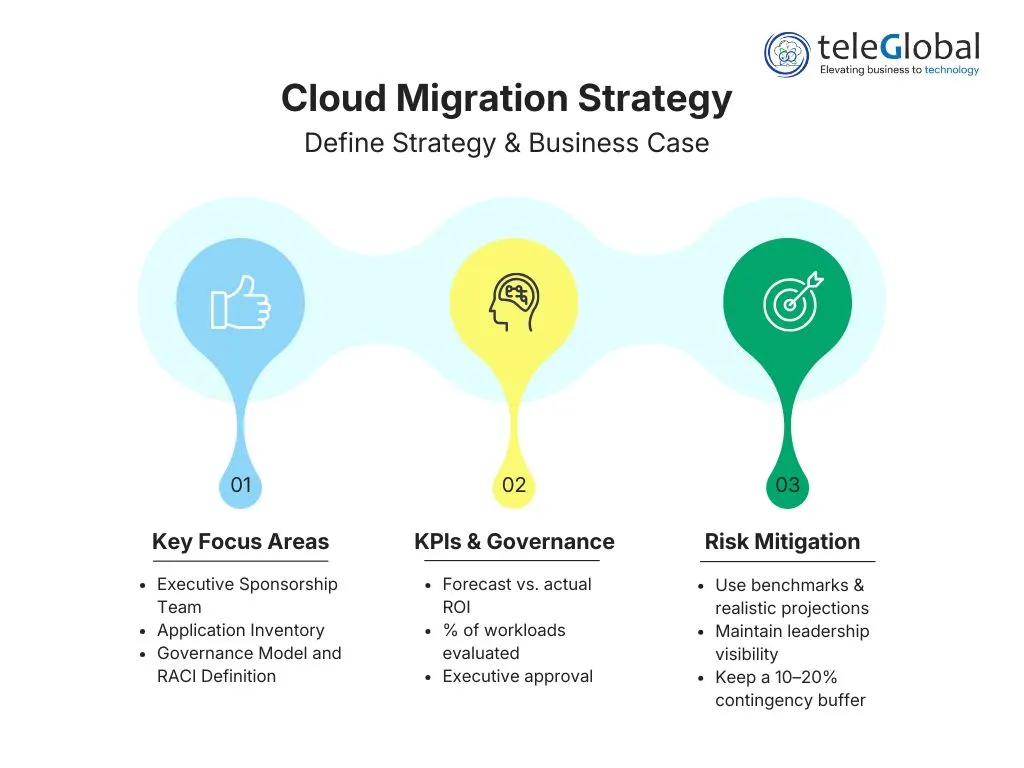
Key Activities: Form an executive sponsorship team (CIO/CTO accountable, CFO consulted, business-unit heads informed). Work with stakeholders to inventory applications and classify by business impact, compliance, and ease of migration. Define governance: create a Cloud Center of Excellence or migration steering committee. Use a RACI matrix to assign roles (e.g. CIO Accountable, IT Ops Responsible, Security Lead Consulted, Users Informed).
KPIs & Governance: Track executive-aligned KPIs such as forecast vs. actual ROI, percentage of workloads evaluated, and stakeholder approval milestones. Typical early KPIs include business alignment index (score how each workload meets strategic goals) and executives signoff on business case. Plan for an initial business case review in 4-6 weeks. Tie each objective to measurable metrics: e.g. reduce hosting costs by X%, improve time-to-market by Y%.
Risk Mitigation: The main risk here is misaligned expectations. Mitigate it by anchoring the plan in realistic numbers and peer data. Use TeleGlobal’s expertise – its Cloud Consulting Services emphasize creating a “cloud migration strategy roadmap” to streamline migration and boost agility. Ensure leadership stays in the loop through RACI accountability, and build a contingency buffer in budgets (e.g. 10–20% contingency).
After strategy, perform a detailed assessment and planning. Conduct a cloud readiness assessment of your existing IT landscape: inventory servers, databases, dependencies, network, security posture, and compliance gaps. This inventory should be automated where possible. Identify application categories (e.g. by business-critical vs. infrequently used) and data sensitivity.
With full visibility, prioritize your migration candidates. Use a business-value vs. complexity model (e.g. TIME/portfolio categories) to decide which applications to move first. Also evaluate the cost implications: run a TCO analysis comparing on-premises vs. cloud costs for pilot use cases (TeleGlobal offers such assessments. Importantly, include a cost governance review now – tag each asset owner, budget holder, and define budgets per project.
Key Activities: Engage cross-functional teams (app owners, security, finance, vendors). Perform a risk assessment (downtime risk, data migration risk, compliance risk). Pick initial targets for a pilot migration (Step 4). Develop detailed migration “waves” or phases, grouping similar workloads. Document your chosen cloud models (public, private, hybrid) and providers (AWS, Azure, GCP) for each workload.
KPIs & Timeline: Measure % of inventory completed, number of dependencies mapped, and accuracy of cost forecasts (e.g. predicted vs. actual TCO). An initial assessment and plan can take 1–3 months depending on scale. Set a timeline: e.g. 4 weeks to complete inventory, 2 weeks to analyze data, 2–4 weeks to draft the migration roadmap. Use agile checkpoints to revisit priorities regularly.
Risk Mitigation: The pitfalls here are hidden dependencies and underestimating data complexity. Mitigate by comprehensive discovery (use automated tools and manual validation) and a cautious approach to sensitive data (consider a separate compliance-led checklist). Involve security and compliance teams to address potential data sovereignty or regulatory requirements early. Maintain transparent timelines: if an inventory drags, escalate with interim reports.
With a plan in hand, formalize your governance and operating model. Establish a Cloud Center of Excellence (CCoE) or steering group to oversee the migration. This team typically includes architects, security leads, financial controllers, and a lead “cloud migration manager.” Define clear RACI for all activities: e.g. CFO Accountable for budget, CIO Accountable for overall migration, project managers Responsible for execution, and business sponsors Consulted.
Implement cloud policies now: set naming/tagging standards, security baselines, and cost ownership rules. An early FinOps practice should tag all resources by owner and project (this prevents “bill shock” later). Decide on tools for governance (cloud management platforms, CMDB integration). Consider creating a “Cloud Playbook” document outlining processes (onboarding new teams, approving deployments, handling incidents), this keeps the approach consistent.
KPIs & Governance: Track governance effectiveness through metrics: policy adherence rate, percentage of resources correctly tagged, and number of security incidents caught pre-migration. Another key metric is “time to decision”: how quickly can a new cloud change be approved under this model? Set a monthly review cadence for the CCoE to assess progress. A lean governance ensures progress without bottleneck – use RACI to keep approvals from slowing work.
Risk Mitigation: Without governance, costs explode and controls fail. Combat that by enforcing early: e.g., disable creation of new accounts or untagged VMs. Train teams on the RACI framework: ensure they know their responsibilities. If talent is a gap, consider TeleGlobal’s managed services to supplement (or hiring a migration architect). Keep executive oversight – a monthly “cloud sprint review” to check KPIs can catch issues (e.g., rising cost overruns or security gaps) before they escalate.
Before a full migration, run a pilot or proof-of-concept. Design your target cloud architecture and security, then test it on a small, non-critical workload. This step validates your assumptions (performance, integration, user experience) and uncovers hidden issues early. Choose an application that represents typical technical challenges.
In parallel, finalize architecture: define network topology, identity management (IAM), data flows, and resiliency mechanisms. Use best practices (e.g. AWS Well-Architected or Azure CAF). Engage your cloud provider specialists (AWS Solutions Architects, Azure experts) for design reviews. Meanwhile, prepare for data migration: set up secure VPN or cloud direct links and test data transfer tools (e.g. AWS DMS, Azure Migrate).
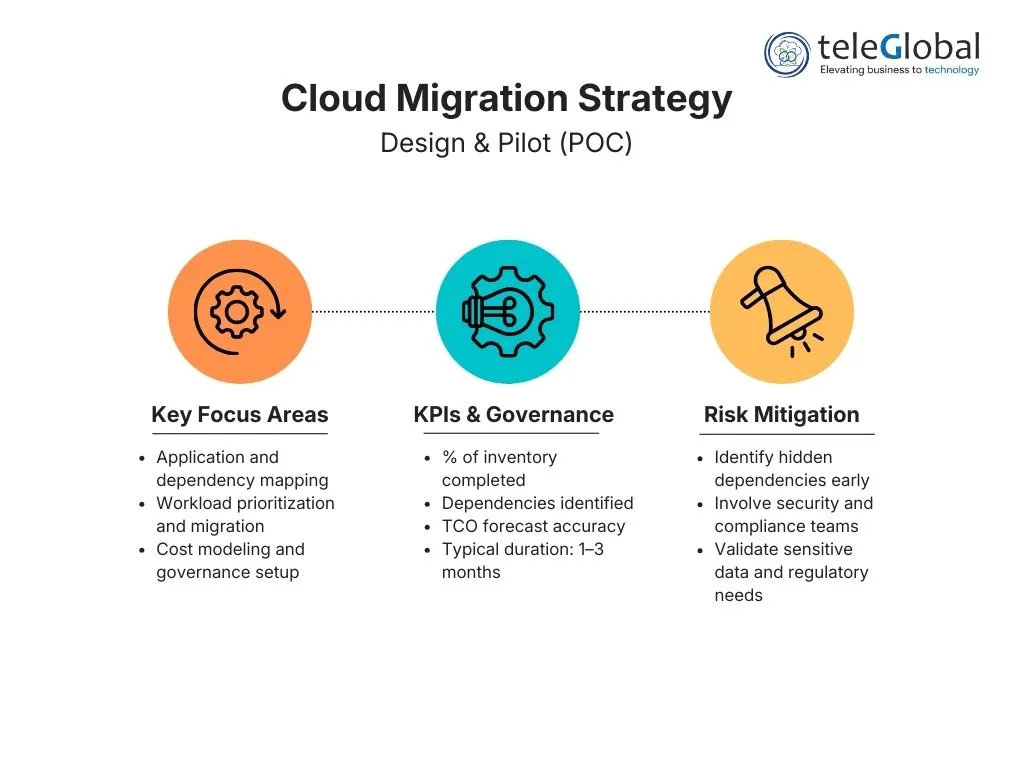
KPIs & Outcomes: Success criteria for the pilot should be clear. For example, achieve X% of baseline performance, zero major security flaws, and user acceptance tests passed. Typical KPIs: time to deploy, downtime during cutover, and % reduction in manual effort. Use this pilot to refine your timeline estimate – e.g. if migrating 1 server takes 2 days, then 100 servers will take ~200 days (adjust for parallelism).
Risk Mitigation: A pilot helps prevent large-scale failure. Record lessons learned: deploy rollback plans and test them. If any issues appear (e.g. latency higher than expected, configuration bugs), fix them before scaling. Document these fixes in your migration playbooks. Ensure executive sponsors see pilot results – demonstrating early wins (and mitigated issues) builds confidence in the plan.
Execute the migration waves as planned. Move applications in phases, typically starting with lower-risk systems. Common approaches include rehosting (“lift-and-shift”), replatforming, or refactoring per the 7 Rs strategies. Use automation and tools wherever possible (infrastructure as code, database replication services) to accelerate the process and reduce errors.
Track each wave rigorously. Before cutover, snapshot systems, freeze changes, and communicate downtime windows to stakeholders. After each wave, validate applications (smoke tests, performance tests) before declaring success. Maintain a cloud support team on standby during migration windows for quick rollback or hotfixes.
KPIs: Monitor migration success rate (percentage of resources migrated on time with no post-migration incidents). Measure downtime per migration and cumulative project progress (e.g. % of total servers/databases migrated). Also track cost variance between forecast and actual consumption for each wave. Visualize dependencies to ensure no critical service is left in a vulnerable state; adjust sequencing if needed.
Risk Mitigation: Main risks are downtime and data loss. Mitigate via phased cutovers and robust backups. Always have a rollback plan if a migration wave fails validation. Keep security scanning active, do not assume the move was perfectly secure. Update firewall, VPC, or NSG rules in tandem with migration; leaving overly permissive rules is a common pitfall. Address vendor lock-in concerns by abstracting as much as possible: for example, use containers or Terraform to keep deployments cloud-agnostic. TeleGlobal’s experience is that thorough testing and incremental rollout are key – there’s no one-size-fits-all, so adapt as you go.
Once services run in the cloud, implement FinOps (cloud financial operations) best practices. According to Deloitte, companies that establish FinOps can save billions (and cut cloud costs up to 40%). Assign financial ownership of resources (via tagging) so each department is accountable for its spend. Set budgets and alerts in your cloud consoles, enforce approvals for unplanned expenses.
Regularly analyze billing data: identify idle resources, oversized instances, and orphaned storage. Rightsize or shut down anything unused. Use reservations or savings plans where predictable (e.g. reserve instances in AWS). Engage treasury or procurement early to negotiate enterprise discounts with providers. Adopt tools (AWS Cost Explorer, Azure Cost Management, or third-party FinOps tools) to gain visibility. The key is a culture shift: finance and IT jointly review cloud spend monthly.
KPIs: Track cloud spend vs. budget, % of spend with defined owner, and waste reduction rate. For instance, monitor percentage of resources in an “idle” state (some organizations find ~27% waste). Measure cost savings from optimization actions (e.g., unused VM shutdowns). Aim for industry benchmarks: many firms eventually identify 20–30% savings through FinOps practices.
Risk Mitigation: Without FinOps, overruns are common. In fact, 50% of firms overshot their cloud budget (by ~15% on average). Avoid this by early tagging discipline and cross-team accountability. If spend is unpredictable, use cloud provider forecasts and historical data to refine budgets. Educate teams on spend impact – a chargeback/showback model often helps (the team that uses it sees the bill). Finally, balance optimization with agility: do not become paralyzed negotiating every dollar. Aim for an iterative FinOps maturity: start by stopping waste, then pursue advanced cost engineering (e.g. using AI-driven tools for predictive budgeting).
Migration isn’t the finish line, now you optimize. Monitor performance, reliability, and security 24/7. Utilize cloud-native services to improve your apps (managed databases, serverless functions, advanced analytics). Regularly review your architecture in a “well‑architected review” or similar to catch inefficiencies. Automate routine operations (CI/CD for deployments, auto-remediation scripts).
Use the cloud’s elasticity: set up auto-scaling for web tiers or batch jobs so you pay only for what you use. Apply the lessons from Step 4 at scale: if your pilot revealed a better instance type or storage tier, roll that out everywhere. Establish feedback loops between Dev, Ops, and Finance to continuously refine workloads. This is also the time to leverage advanced capabilities (AI/ML, IoT services, global CDN, etc.) as new innovations.
KPIs: Focus on business-level outcomes: uptime (e.g. 99.9%+), customer satisfaction, and time-to-market for new features. Track operational KPIs too: system response time, infrastructure utilization, and adoption of cloud services. Critically, measure ROI realization – compare actual cost savings or revenue gains to your original business case. A typical success story: a “lift-and-shift” may yield 20-30% lower costs initially, but further re-architecting can double that benefit over 12–18 months.
Risk Mitigation: Don’t revert to old habits. Guard against “cloud drift” – where configuration diverges across environments. Conduct quarterly reviews to ensure security patches are up-to-date and configurations match your standards. Encourage a culture of continuous improvement (e.g. DevOps or SRE practices) to keep innovating. As your footprint grows, revisit Step 2’s governance: update policies, scales up your FinOps team, and consider multi-cloud strategies if business needs evolve.
Even the best plans face hurdles. Here are some typical migration challenges and leadership actions:
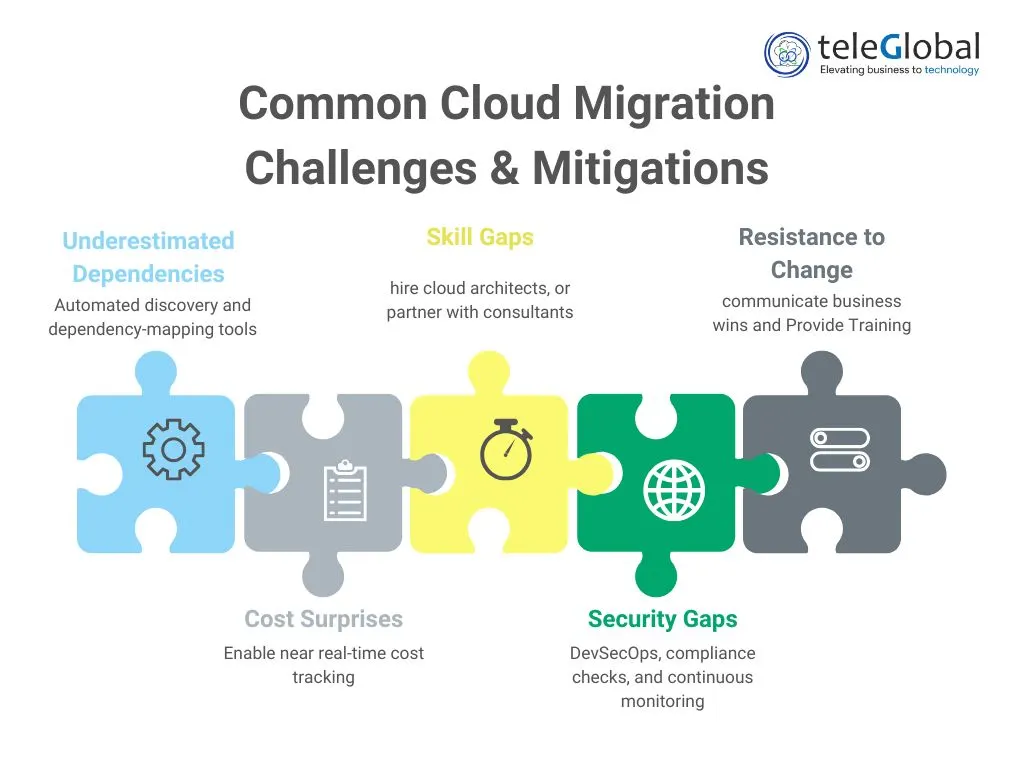
Above all, keep governance strict and communication frequent. Regular status updates to stakeholders, transparent KPIs, and quick action on issues will keep the plan on track.
A successful cloud migration demands a balance of strategic vision and disciplined execution. By following these 7 steps from defining objectives through continuous optimization – executives can ensure the project drives real business value. Leadership attention to governance, KPIs, and cost oversight (FinOps) will keep the plan on track.
Ready to accelerate your migration? Teleglobal offers deep expertise at each stage. From a complimentary Cloud Infrastructure Assessment to hands-on migration and managed services, TeleGlobal’s team can partner with you to execute this plan. Consider exploring TeleGlobal’s Cloud Consulting Services and past success stories (e.g. 90% storage cost reduction) as you move forward.
Get started today to capture cloud agility and savings before your competitors do.
It depends on scope and complexity. Small pilots can be done in weeks, but full migrations often take 6–18 months. We recommend phased waves (by application or service) spread over 6–12 months, with continuous optimization after go-live. In practice, an initial strategy & pilot might take 3–4 months, followed by several migration sprints (each 4–8 weeks).
Focus on business outcomes. Key metrics include budget variance (actual vs. projected cost), ROI (e.g. percentage reduction in TCO), application performance (latency, uptime), and project milestones (e.g. % of workloads migrated). Track security/compliance metrics too (e.g. number of vulnerabilities found/fixed). Also measure operational agility (time to provision a new resource).
Adopt a FinOps culture. Tag every cloud asset with an owner and business unit. Set budgets and alerts in the cloud portal. Conduct monthly spend reviews (down to the project or team level) and optimize unused capacity immediately. Use reserved instances or long-term commitments for steady workloads. Deloitte notes that organizations implementing FinOps can cut cloud spend by ~30–40%.
A pilot de-risks the entire project. It validates the migration approach on a small scale: you confirm performance, security, and integration without impacting critical services. The pilot’s success criteria (speed, stability, cost) then become a template for the larger roll-out. Most consultants recommend always piloting a representative workload before moving business-critical systems.
We advise a RACI matrix and a Cloud Center of Excellence. For example, designate a cloud leader as Accountable, IT teams as Responsible, security and finance as Consulted, and business stakeholders as Informed. Regular steering meetings (bi-weekly or monthly) should review progress against KPIs. A common best practice is to have a small cross-functional team decide policy exceptions, ensuring agility while maintaining control.
Build realistic timelines that include testing and buffers. For instance, budget extra time for unexpected issues (network cutovers often take longer). Lock down timelines in the business case stage. Communicate any shifts immediately. Keep the board informed of critical path items: any change (e.g. scope creep or vendor delay) should trigger a governance review so executives know the new timeline and impact.
 close
close

Hi there! At TeleGlobal, we turn your cloud vision into AI-accelerated reality. What challenge can we help you solve?
Powered by ![]() teleBot
teleBot